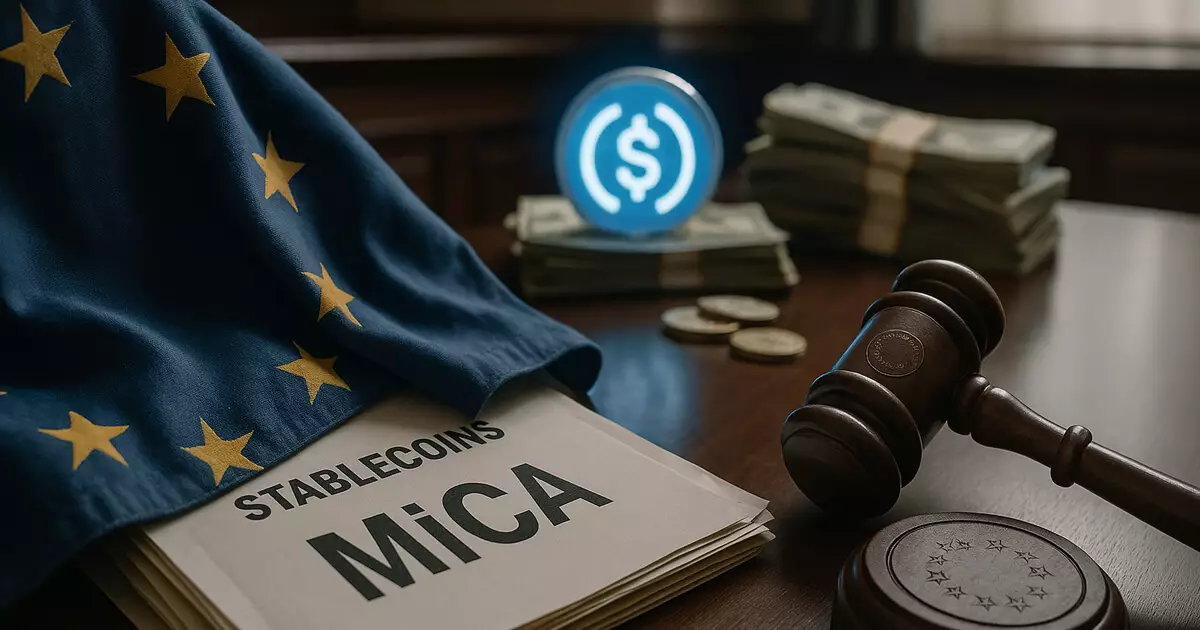In an age where digital currency has become indispensable for global commerce, the European Union’s Markets in Crypto Assets (MiCA) regulation seems to wield a double-edged sword. Intended to foster safety and clarity in the cryptocurrency space, MiCA paradoxically tightens the noose on euro-denominated stablecoins, thereby reinforcing the stronghold of the U.S. dollar over global financial markets. The irony here is profound: by over-regulating stablecoins, the EU isn’t just hindering innovation; it is inadvertently cementing the dominance of the American financial system at a time when the world yearns for diversity in currency options.
The notion that regulation equates to consumer protection often overlooks a fundamental truth: excessively stringent controls can suffocate innovation. Euro-denominated stablecoins could have served as viable alternatives to their USD counterparts; however, the MiCA regulations make it exceedingly challenging for such entities to thrive. Regulation should empower, not inhibit—yet, in this instance, MiCA appears to espouse the latter approach.
Stablecoins: The Unsung Heroes of Digital Transactions
In the current landscape, where speed, transparency, and borderless transactions reign supreme, stablecoins are invaluable. These digital assets play an essential role in enhancing liquidity and enabling seamless financial interactions. Over 99% of the stablecoins circulating today are pegged to the U.S. dollar, a testament to both its historical strength and the regulatory vacuum left by the EU.
Instead of presenting an alternative framework to challenge this concentration of power, Europe has chosen to stifle it, hindering the emergence of competitive euro-backed stablecoins. By doing so, policymakers are not just displaying a lack of foresight but are also responding to market dynamics with a misguided authoritarianism. The result? A deleterious impact on the very financial ecosystem they aim to protect.
Centralized Control vs. Market Innovation
The EU’s announcement that it favors a central bank digital currency (CBDC) over stablecoin development has far-reaching implications. While central bank initiatives might seem progressive, the historical reality indicates they frequently lack the speed and adaptability inherent in private sector innovations. CBDCs can raise a host of concerns, ranging from issues of privacy to potential governmental overreach—factors that could repulse consumers rather than attract them.
The U.S., on the other hand, showcases a compelling counter-narrative. By allowing the private sector to spearhead the innovation of stablecoins, American regulators create a fertile ground for rapid advancements in financial technologies. It is astonishing, and frankly disappointing, that Europe finds itself trapped in a bureaucratic web while its transatlantic counterpart thrives, pillaring an ecosystem that is dynamic and resilient.
A Strategic Blunder with Global Consequences
What Europe has failed to grasp is that its stringent MiCA regulations are more than a missed opportunity—they represent a strategic blunder with far-reaching geopolitical repercussions. By continually suppressing euro-stablecoin innovation, Europe risks not only the euro’s relevance in the digital age but also its standing as a competitor to the dollar. Coupled with the increasing power of non-Western currencies and alliances—like the emerging BRICS framework—the EU could find itself further marginalized on the global stage.
The ongoing evolution of blockchain technologies and their capacity to revolutionize commerce and finance demand that Europe reassess its regulatory posture. As nations embrace less dogmatic regulatory frameworks, the caution exhibited by the EU might very well turn it into a passive observer rather than an active participant in shaping the future of finance.
Embracing Innovation to Secure the Euro’s Future
To salvage its ambitions for the euro and re-establish itself as a global competitor in digital currency, the EU must shift its paradigm. The embrace of stablecoin innovation, rather than its regulation into oblivion, could supply the competitive edge that is so desperately needed.
As we stand on the brink of a new economic era, those who choose to hinder progress will inevitably be surpassed by those who champion it. Unless the EU recognizes this critical juncture, the MiCA regulation may indeed spiral into an era of irrelevance, allowing the U.S. dollar to flourish while the euro languishes. The question persists: will Europe adapt, or will it remain a spectator, watching as innovative nations seize the future?

